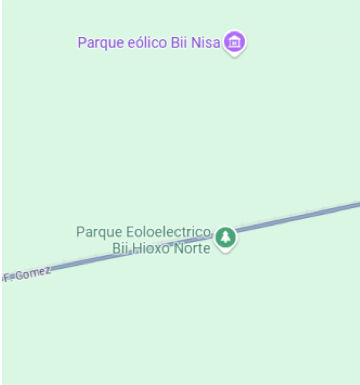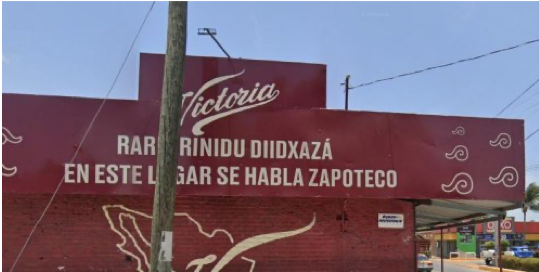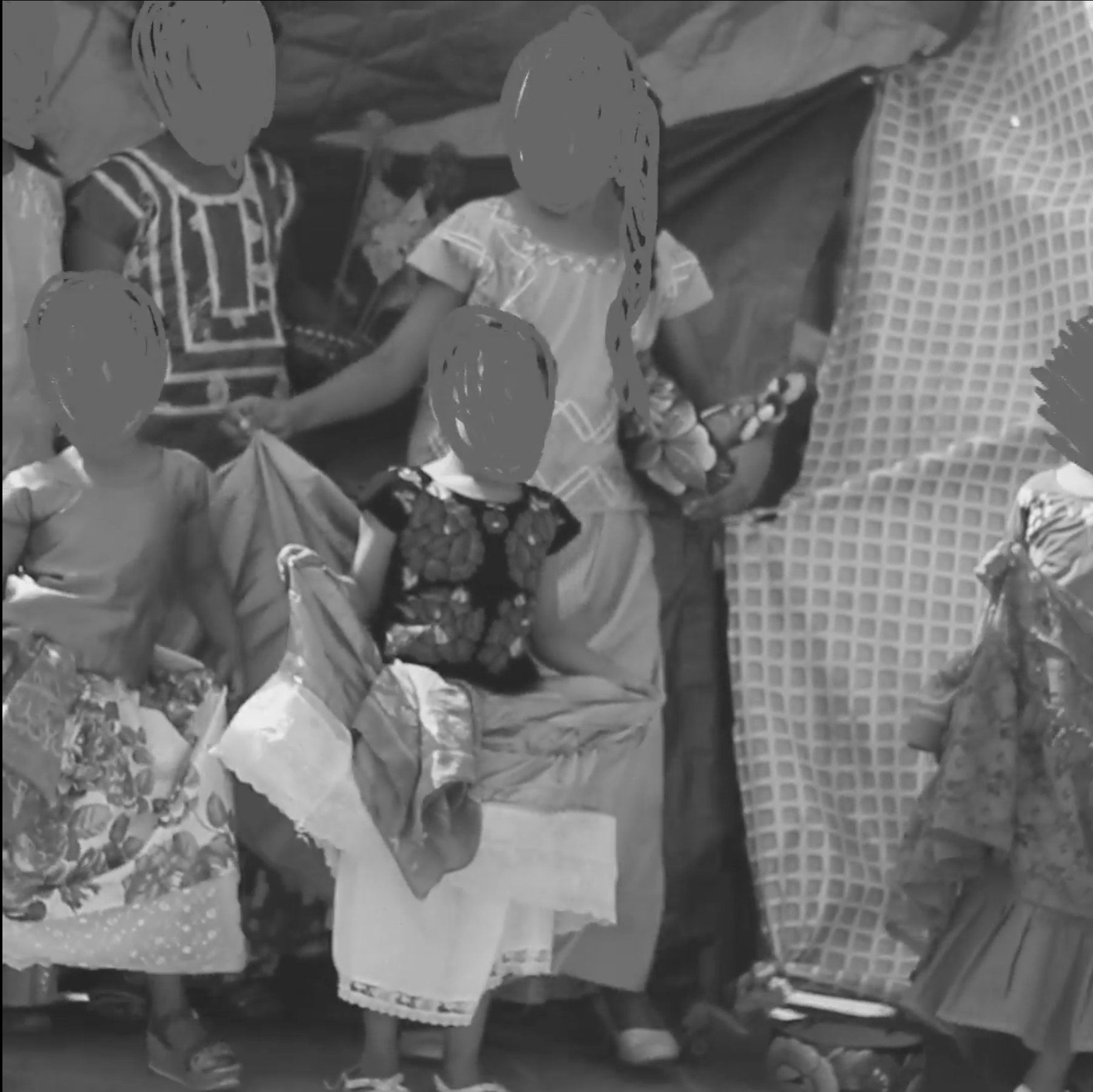When I was seven years old, an aunt came by my house to tell us about a murder that had taken place in the community. It happened during a rodeo, a community event where men ride large bulls and compete against each other. This activity takes place during the town’s patron saint festivities. In short, a man was watching his bull compete, drinking mezcal and shouting euphorically, when another man arrived on a motorcycle and shot him without saying a word.
I imagined the scene: the music accompanying the moment blending with the voices of the street vendors in Zapotec, the wind kicking up dust that sometimes obscures your vision, and it was right in that blind spot when the shot rang out, a sound that slipped away amid the thunder of firecrackers launched into the sky, a sound that did not belong to the community’s soundscape.
The man’s body was lying on the pavement. My aunt said that the blood from the gunshot filled the potholes in the concrete street, caused by poor construction or wear and tear from foot traffic.
That blood turned into a stain, and on top of that stain, the community placed a white painted cross with flowers and candles. I was afraid of walking down that street. Several months had passed, and I preferred to turn around the block. The name of the street was 16 de Septiembre, at the corner of Xicoténcatl and San Jerónimo, but in my memory, it is the place where a man was murdered.
–Ridxiibi– which in English means “they are afraid”, was a phrase my mother used to say when I would refuse to walk down that street. I still don’t know what I was afraid of: the body lying on the pavement, the white cross that reminded me of what had happened, or the sound of firecrackers, which is similar to a gunshot. Sometimes, while I was playing, I would forget, and then suddenly I would remember again that someone had been killed near my house.
I have been thinking about this again recently and asked myself: How many streets must I avoid because they bear the marks of violence? How many roads in my community no longer belong to us because of fear? This is what the following text is about, the fear of living in the community. Unfortunately, there are now more streets in the Zapotec community of the Isthmus of Tehuantepec with traces of violence, and if this continues, it will be very difficult to walk down them.
The present situation
The Isthmus region has been recognized as an area of interest for entrepreneurs and for the government itself, and the idea of developing the community through megaprojects. Due to its strategic location, the Mexican government has also recognized the Isthmus as an area of interest for organized crime.
While the Mexican government’s rhetoric of development and transformation in the isthmus reached the media as a moment of economic boom and touted the benefits to the people of low electricity costs in exchange for investment in wind power companies, on the other side of the story, the violent dispossession of land was growing, while crime and threats against farmers and ejido members were becoming increasingly frequent.
The mega-companies set up a kind of exchange that consisted of an annual or monthly payment and the option of a job for their children in the companies involved in these mega-projects, thus securing their future. Agreements were made with universities, planning internships for future graduates and the possibility of going abroad. The agreement seemed to be a win-win for everyone, but the Zapotec community had given up part of its future.
It would appear that the dispossession is merely territorial, which is serious enough, but the most interesting aspect of this development model is the way in which identity has been used as a campaign for inclusion in favor of these companies.
Companies have expropriated the community’s natural and intellectual resources, creating an inclusion plan that makes us believe it is natural to see them there, existing among us. You could say it is a type of identity appropriation. They have created their own celebrations (town festivals), their publicity in Zapotec, and their investments in traditional workshops where they force children to thank the companies, as if recycling the example of colonization that existed in those years.

Names in Zapotec of existing wind farms in the Zapotec territory of the Isthmus of Tehuantepec found on Google Maps.

Advertisement for Victoria beer in a shop in the center of El Espinal, Oaxaca.
These ideas and propaganda have caused significant changes in the community and increased rates of violence. Social organizations that previously represented the interests of rural communities have become divided, immersed in political structures and corruption that serve the interests of these powerful elites.
There are plenty of extracurricular workshops for children and youths, but they remain empty. The vast majority of those who should be attending are involved in petty drug dealing, while others have decided to migrate because they have wasted too much time waiting for a job opportunity in these companies that made so many promises.
Violence has permeated the community; its way of life has changed so fast that it’s hard to imagine living safely there. One example of this change is in how women dress, who have stopped wearing real gold to avoid the high crime rate and instead wear imitation jewelry.
The community is seeking to adapt to these new realities. We walk through empty, dark streets, and the busiest places have been taken over by fear. The park, the main transport stops, and some food stalls have ended up in the crime reports due to this wave of violence.
This is a type of plunder: the fear of inhabiting community spaces. Daylight also remains uninhabited due to the wave of violence that is seen by the population as a threatening message to all: “be careful while you walk.”
Music, songs, and big parties remain part of people’s everyday life, accompanied by fireworks that are sometimes mistaken for gunshots. Violence has contaminated our memory, and we are unsettled when we wonder whether what we hear is fireworks or an armed assault, since both are now very common.
The Community
Fear transcends the community, it sticks to people’s homes and throats. In their desperation to find safety, people fall into prejudice, pointing to neighboring towns as the most violent, pointing to education, prestige, clothing, tattoos, etc.
People living in the town’s outskirts suffer twice as much from this prejudice: those who live near the river are labeled as criminals, families living in the upper parts of the town are rejected because they are strangers in their own community, and the section of the community known for its rebelliousness is considered, in the community’s own narrative, a “nest of criminals.” Yet we continue to fail to point the finger at those who are truly to blame.
The violence brought about by capitalism has divided the community, extinguishing it within these exclusionary phrases. This has been one the most damaging consequences for us as a people.
The sickness
Fear is a disease; that’s how it’s seen by the people. Fear closes your throat and gives you a high fever. It also attacks your hands, making them stiff, your eyes become heavy, and in more severe cases, it causes alopecia.
Fear is a blockage that prevents air from flowing through the body, the air that carries blood to the mind and heart. This blockage prevents one from eating and drinking, and causes a loss of motor skills. For the older people in my village, Asunción Ixtaltepec, Oaxaca, when someone is afraid or frightened, they should not drink water or eat quickly. They must take their time so that the air can flow through the body again, otherwise, the blood can turn to water and lose its red color, becoming pale and causing anemia.
The way people deal with fear in the community is by blowing on it with fresh leaves that are passed over the ear, eyes, and mouth in order to push out the air stuck in the body or remove the blockage. When this happens, people usually cry and begin praying for peace for their soul.
Thinking about how there is a blockage of fear in the community that was created by violence, a blockage that prevents air from flowing, I wonder: What would be the breath of fresh air that could help unblock it? And what has caused our demands to live and move freely in our safe spaces to be silenced?
This blockage prevents us from seeing the current situation, has prevented us from speaking out and demanding our rights, has divided the community, and has led us to accept crumbs of attention from the West in exchange for our plundered resources and extractivism in all its forms.
I imagine that blockage has prevented cultural spaces from being filled because the attendees are being murdered, has diminished the sound of demands because those voices are disappearing, the little importance of natural resources. I imagine that the lack of air has turned our blood colorless like water, as a sick and divided community. Thus, there are few who resist, but there are more who do not pay attention, worrying about trivialities. It is that same blockage that has not allowed children to transit the community without fear.
The Prayer: Conclusion
Prayer is born of necessity, it is the fervent desire for a miracle, a prayer is insistent, tiring, and exhausting, made repeatedly in order to reach heaven or to find hope.
In a community of changes, dispossession, violence, of a militarized scenario that seeks to disinhabit us, it seems that violence has stripped us of our soul. Fear obstructs our sense of belonging, we can no longer say that to recover the Zapotec identity we need to rescue our identity such as language or traditions, because we also need to preserve life itself, since there will be no one who can inhabit it.
In this hopelessness that we are living, prayer emerges from all these people who have collaboratively sought to protect the dignity and the right to inhabit our territories, who have created spaces in the face of the need to talk about the demands and who have carefully engaged in conversation with the violence itself.
In the midst of uncertainty, people continue to search for peace through action; youth collectives strike precise blows to the current situation, to fear, through the arts. Reaffirming a discourse of demands, it is no longer only about portraying the beautiful culture and traditions but about carefully demanding a stop to the bloodshed.
Likewise, their prayers become memory, when through the activities they remember the injustices, disappearances, femicides, and transphobia that the community wears. An example of this is the candle of the intrepid women seekers of danger, who before starting their great dances have created a cultural week where they demand a stop to violence and discrimination in these spaces. This is just one example of a prayer, and there are many more like it.
Developing community should be understood from these violent times, as the air that helps to unclog the blockage to let the community’s blood flow, and at the end of the day we must try to understand community action as a self-defense against violence as well as a way of life.

-150x150.jpg)